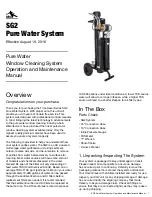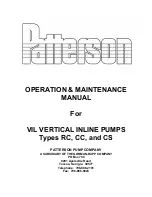
ENGLISH
14
5.
MANAGEMENT
5.1 Storage
All the pumps must be stored indoors, in a dry, vibration-free and dust-free environment, possibly with constant air humidity.
They are supplied in their original packaging and must remain there until the time of installation.
5.2 Transport
Avoid subjecting the products to needless jolts or collisions.
The electropumps must never be carried or lifted by their power cables.
5.3 Weight
The adhesive label on the package indicates the total weight of the electropump.
6.
WARNINGS
6.1 Safety
-
The pump must
never
be allowed to run dry.
-
The pump cannot be used in swimming pools, ponds or tanks in which people are present.
-
The pump is provided with a hook to which a rope or cable may be connected to lower the machine into working position.
The pumps must never be carried, lifted or made to operate hanging from their power cables.
-
Qualified personnel must be employed for all electrical repairs which, if badly carried out, could cause damage and accidents.
6.2 Checking rotation of the PULSAR motor shaft
If the motor does not work and the shaft does not turn when the switch and/or float is operated, you must check that the moving parts are
turning freely.
To do this:
-
Completely disconnect the pump from the power mains.
-
Place the pump in a horizontal position.
-
Remove the filter cover, slackening the three screws with a screwdriver.
-
Using a size 13 box spanner, slacken the self-locking nut and turn the motor shaft in a clockwise direction.
-
Replace the filter cover and install the pump as indicated in chapter 7.
6.3 Checking rotation of the PULSAR DRY motor shaft
If the motor does not work and the shaft does not turn when you switch on the pump, you must check that the moving parts are turning freely.
To do this:
-
Completely disconnect the electropump from the electric power mains.
-
Place the electropump in horizontal position.
-
Remove the steel base, slackening the eight screws and nuts with a spanner.
-
Using a size 13 hexagonal box spanner, adjust the self-locking nut and turn the motor shaft in a clockwise direction.
-
Replace the steel base and install the electropump as indicated in chapter 7.
6.4 Cleaning the PULSAR filter
To clean the filter, proceed as follows:
-
Place the pump in a horizontal position.
-
Remove the filter cover, slackening the three screws with a screwdriver.
-
Clean the inside of the filter, removing any particles that may have been sucked in.
-
Check that the various filter slots are free from foreign bodies.
-
Replace the filter cover and install the pump as indicated in chapter 7.
7.
INSTALLATION PULSAR
–
PULSAR DRY
7.1 Site of installation of the PULSAR (Fig. 1, pag. 1)
•
Before immersing the electropump in the pit or tank, ensure that the place is free from sand or solid sediment.
•
If there is sediment, accurately clean the site where it is to be placed.
•
Keep the pump raised at least 1 mt above the bottom of the pit so that any deposits that form after installation will not be sucked up.
•
Remove the sediment periodically.
•
It is very important to ensure that the water level never falls below the body of the pump. (Fig.1, pag.1).
7.2 Working conditions of the PULSAR
•
Water temperature: from 0°C to +40°C.
•
Pump body always completely immersed.
•
The pump cannot operate when dry.
•
Installation in vertical or horizontal position.
•
The housing pit must be frost-free.
•
Maximum depth of immersion 20 mt. (below water level).
7.3 Site of installation of the PULSAR DRY (Fig. 2, pag. 2)
•
A solid anchoring of the pump to its support base helps absorb any vibrations created by pump operation.
•
Block the pipes with their own supports and connect them so that they do not exert strain, stress or vibration on the pump inlets.
•
It is always good practice to position the pump as close as possible to the liquid to be pumped.
•
It is recommended to fit a foot valve on intake. To avoid the formation of air pockets in the suction pipe, ensure that the suction pipe is
tilted slightly towards the electropump.
•
Provide a hole for priming the pump in the delivery pipe (see paragraph. 9.1).
















































